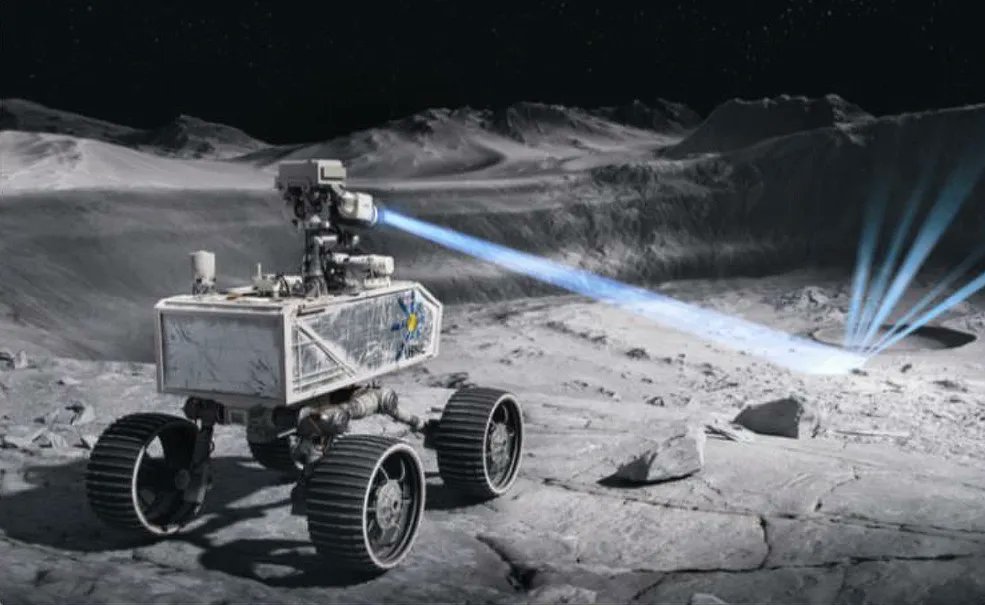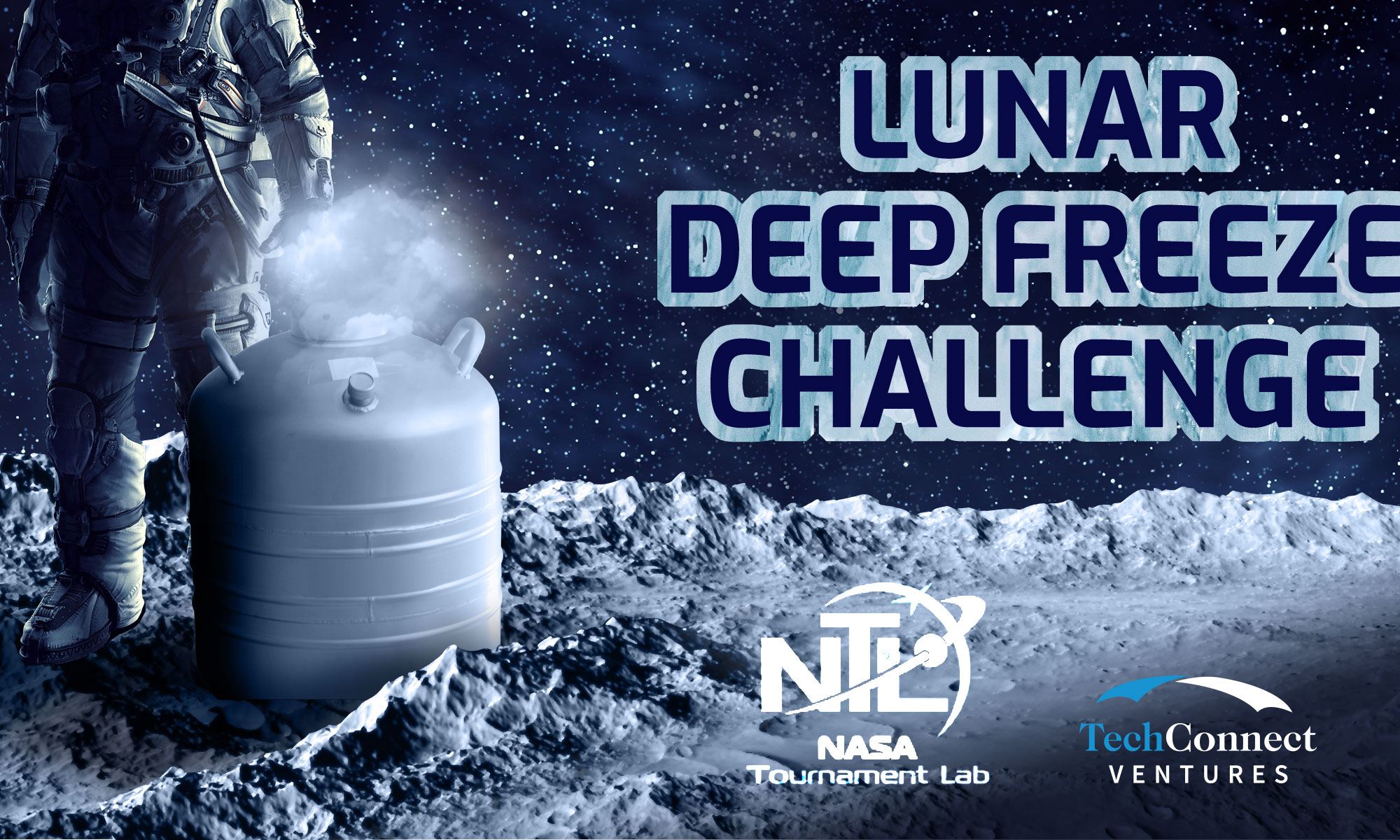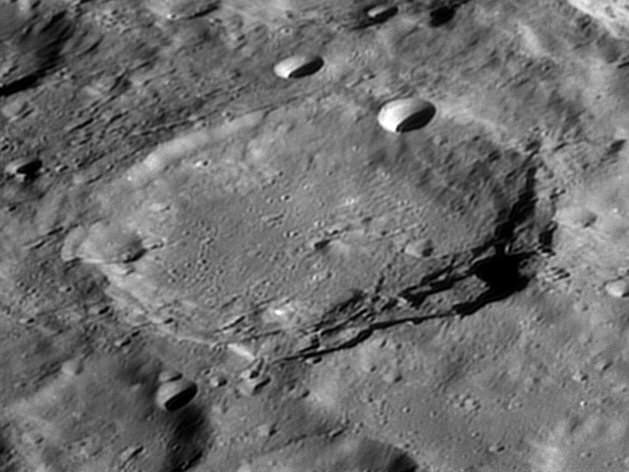Not all flashlights are created equal. Some are stronger, consume more power, or have features such as blinking or strobes. Some aren’t even meant for humans, such as a new project that recently received funding from a NASA Institute for Advanced Concepts (NIAC) Phase I award. Designed by the Ultra Safe Nuclear Corporation (USNC), this flashlight doesn’t emit visible light, but it does emit x-rays and gamma rays, and the researchers on the project think it could be useful for finding resources on the Moon.
Continue reading “A new way to Peer Into the Permanently Shadowed Craters on the Moon, Searching for Deposits of Water ice”NASA Announces 14 New “Tipping Point” Technologies for its Lunar Exploration
In four years, NASA plans to return astronauts to the Moon as part of Project Artemis. To ensure the success of this endeavor, as well as the creation of a program of sustainable lunar exploration by the end of the decade, NASA has partnered with multiple entities in the commercial space sector. Recently, they announced that contracts will be awarded to 14 additional companies to develop a range of proposed technologies.
These proposals are part of NASA’s fifth competitive Tipping Point solicitation, one of many private-public partnership programs overseen by NASA’s Space Technology Mission Directorate (STMD). For this latest solicitation, Tipping Point is awarding contracts with a combined value of over $370 million for technology demonstrations that will facilitate future lunar missions and commercial space capabilities.
Continue reading “NASA Announces 14 New “Tipping Point” Technologies for its Lunar Exploration”NASA Has a New Challenge to Bring Frozen Samples of the Moon Back to Earth
When astronauts return to the Moon for the first time since the Apollo Era, they will be tasked with conducting some very lucrative science operations. Like their predecessors, this will include a sample-return mission, where they bring back lunar rocks and regolith for study. There have also been proposals that renewed missions to the Moon bring back samples of lunar ice so scientists can determine where the Moon’s water came from.
And it appears NASA was listening and would like some public input on this! To this end, the NASA Tournament Lab and TechConnect Ventures (a n open-innovation platform) have come together to launch the NASA Lunar Deep Freeze Challenge. Basically, NASA is looking for ideas on how cold samples collected in the lunar polar region could be preserved and kept frozen for the return trip to Earth.
Continue reading “NASA Has a New Challenge to Bring Frozen Samples of the Moon Back to Earth”Artemis Missions Should Bring Ice Home From the Moon Too

During the Apollo Era, astronauts conducted vital science operations on the Moon, which included bringing samples of lunar rocks back to Earth for study. Thanks to the examination of these rocks, scientists were able to learn a great deal about the formation and evolution of the Moon and even found evidence of lunar water. In the coming years, when NASA sends astronauts back as part of Project Artemis, more samples will be returned.
Recently, NASA put out the call for science white papers to help them design a framework for the kind of science operations the Artemis astronauts will conduct. According to one proposal, the Artemis astronauts should not only bring back samples of lunar regolith or rocks but lunar ice as well. By examining them here on Earth, scientists may finally be able to resolve the mystery of where the Moon’s water came from.
Continue reading “Artemis Missions Should Bring Ice Home From the Moon Too”There May be Thick Ice Deposits on the Moon and Mercury
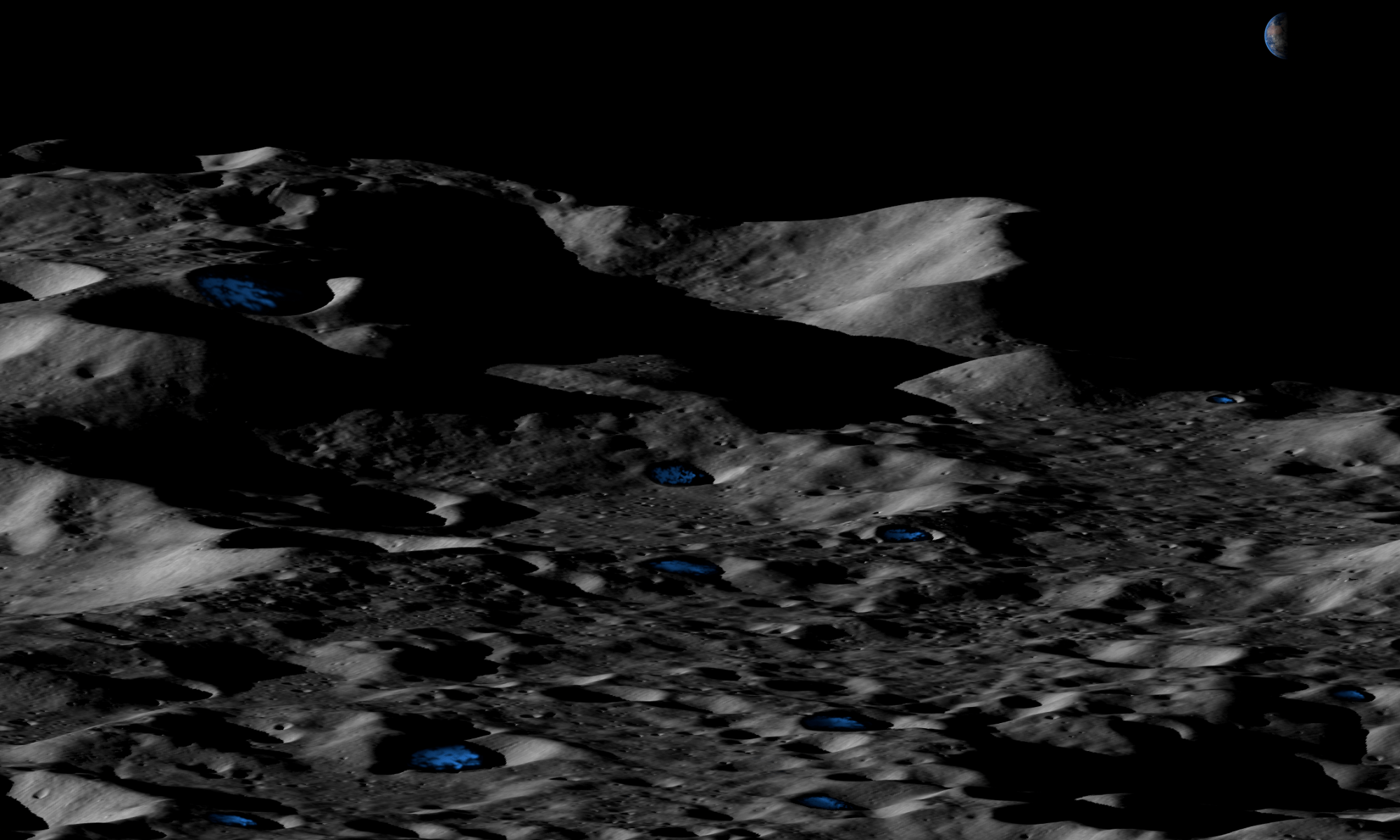
In addition to being the only solvent that is capable of supporting life, water is essential to life as we know it here on Earth. Because of this, finding deposits of water – whether in liquid form or as ice – on other planets is always exciting. Even where is not seen as a potential indication of life, the presence of water offers opportunities for exploration, scientific study, and even the creation of human outposts.
This has certainly been the case as far as the Moon and Mercury are concerned, where water ice was discovered in the permanently-shadowed cratered regions around the poles. But according to a new analysis of the data from the Lunar Reconnaissance Orbiter and the MESSENGER spacecraft, the Moon and Mercury may have significantly more water ice than previously thought.
Continue reading “There May be Thick Ice Deposits on the Moon and Mercury”Dust off Your Lunar Colony Plans. There’s Definitely Ice at the Moon’s Poles.
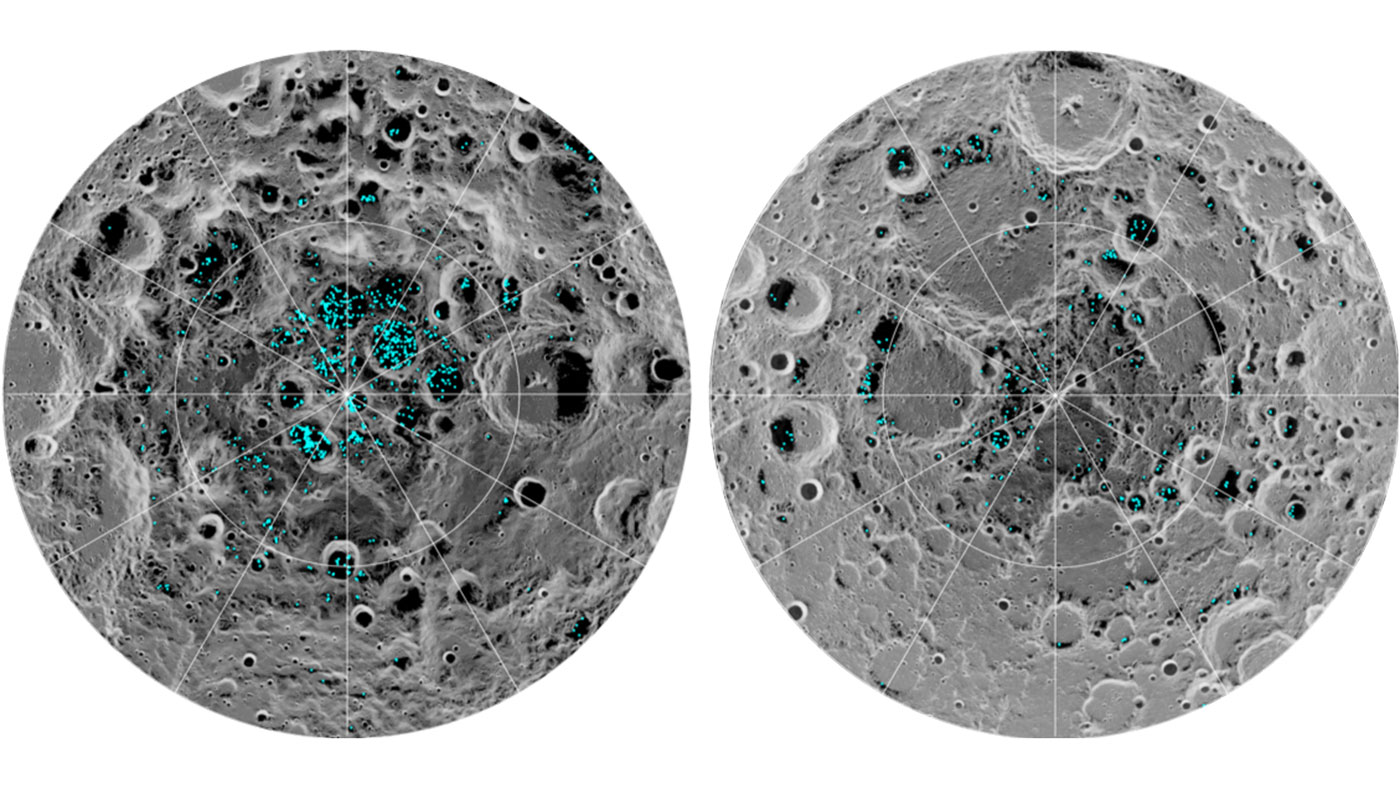
When it comes right down to it, the Moon is a pretty hostile environment. It’s extremely cold, covered in electrostatically-charged dust that clings to everything (and could cause respiratory problems if inhaled), and its surface is constantly bombarded by radiation and the occasional meteor. And yet, the Moon also has a lot going for it as far as establishing a human presence there is concerned.
Continue reading “Dust off Your Lunar Colony Plans. There’s Definitely Ice at the Moon’s Poles.”
More Surface Ice on Mercury than Previously Thought, says New Study

Back in 2012, scientists were delighted to discover that within the polar regions of Mercury, vast amounts of water ice were detected. While the existence of water ice in this permanently-shaded region had been the subject of speculation for about 20 years, it was only after the Mercury Surface, Space Environment, Geochemistry, and Ranging (MESSENGER) spacecraft studied the polar region that this was confirmed.
Based on the MESSENGER data, it was estimated that Mercury could have between 100 billion to 1 trillion tons of water ice at both poles, and that the ice could be up to 20 meters (65.5 ft) deep in places. However, a new study by a team of researchers from Brown University indicates that there could be three additional large craters and many more smaller ones in the northern polar region that also contain ice.
The study, titled “New Evidence for Surface Water Ice in Small-Scale Cold Traps and in Three Large Craters at the North Polar Region of Mercury from the Mercury Laser Altimeter“, was recently published in the Geophysical Research Letters. Led by Ariel Deutsch, a NASA ASTAR Fellow and a PhD candidate at Brown University, the team considered how small-scale deposits could dramatically increase the overall amount of ice on Mercury.
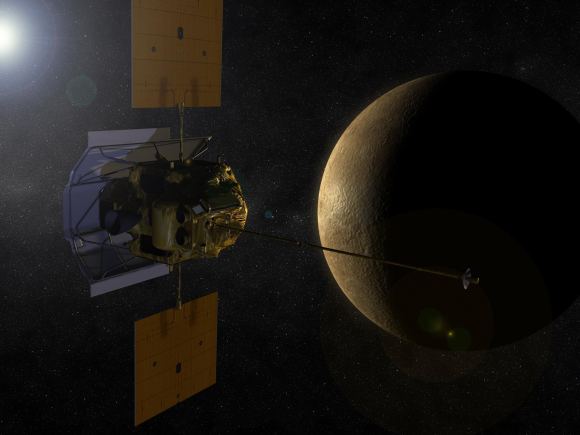
Despite being the closest planet to the Sun, and experiencing scorching surface temperatures on its Sun-facing side, Mercury’s low axial tilt means that its polar regions are permanently shaded and experience average temperatures of about 200 K (-73 °C; -100 °F). The idea that ice might exist in these regions dates back to the 1990s, when Earth-based radar telescopes detected highly reflective spots within the polar craters.
This was confirmed when the MESSENGER spacecraft detected neutron signals from the planet’s north pole that were consistent with water ice. Since that time, it has been the general consensus that Mercury’s surface ice was confined to seven large craters. But as Ariel Deutsch explained in a Brown University press statement, she and her team sought to look beyond them:
“The assumption has been that surface ice on Mercury exists predominantly in large craters, but we show evidence for these smaller-scale deposits as well. Adding these small-scale deposits to the large deposits within craters adds significantly to the surface ice inventory on Mercury.”
For the sake of this new study, Deutsch was joined by Gregory A. Neumann, a research scientist from NASA’s Goddard Space Flight Center, and James W. Head. In addition to being a professor the Department of Earth, Environmental and Planetary Sciences at Brown, Head was also a co-investigator for the MESSENGER and the Lunar Reconnaissance Orbiter missions.
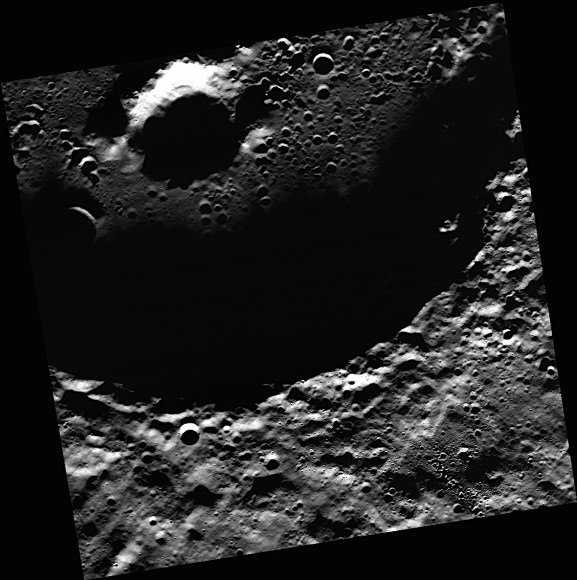
Together, they examined data from MESSENGER’s Mercury Laser Altimeter (MLA) instrument. This instrument was used by MESSENGER to measure the distance between the spacecraft and Mercury, the resulting data being then used to create detailed topographical maps of the planet’s surface. But in this case, the MLA was used to measure surface reflectance, which indicated the presence of ice.
As an instrument specialist with the MESSENGER mission, Neumann was responsible for calibrating the altimeter’s reflectance signal. These signals can vary based on whether the measurements are taken from overhead or at an angle (the latter of which is refereed to as “off-nadir” readings). Thanks to Neumann’s adjustments, researchers were able to detect high-reflectance deposits in three more large craters that were consistent with water ice.
According to their estimates, these three craters could contain ice sheets that measure about 3,400 square kilometers (1313 mi²). In addition, the team also looked at the terrain surrounding these three large craters. While these areas were not as reflective as the ice sheets inside the craters, they were brighter than the Mercury’s average surface reflectance.
Beyond this, they also looked at altimeter data to seek out evidence of smaller scale deposits. What they found was four smaller craters, each with diameters of less than 5 km (3 mi), which were also more reflective than the surface. From this, they deduced that there were not only more large deposits of ice that were previously undiscovered, but likely many smaller “cold traps” where ice could exist as well.
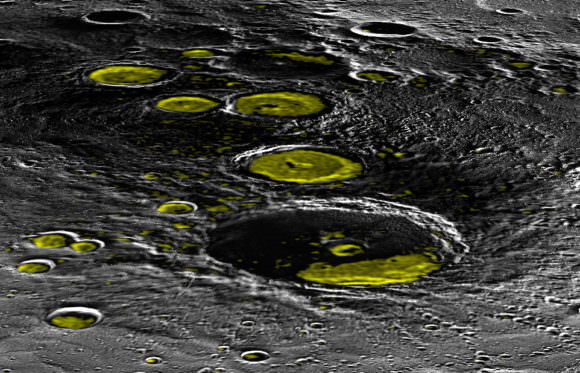
Between these three newly-discovered large deposits, and what could be hundreds of smaller deposits, the total volume of ice on Mercury could be considerably more than we previously thought. As Deutsch said:
“We suggest that this enhanced reflectance signature is driven by small-scale patches of ice that are spread throughout this terrain. Most of these patches are too small to resolve individually with the altimeter instrument, but collectively they contribute to the overall enhanced reflectance… These four were just the ones we could resolve with the MESSENGER instruments. We think there are probably many, many more of these, ranging in sizes from a kilometer down to a few centimeters.”
In the past, studies of the lunar surface also confirmed the presence of water ice in its cratered polar regions. Further research indicated that outside of the larger craters, small “cold traps”could also contain ice. According to some models, accounting for these smaller deposits could effectively double estimates on the total amounts of ice on the Moon. Much the same could be true for Mercury.
But as Jim Head (who also served as Deutsch Ph.D. advisor for this study) indicated, this work also adds a new take to the critical question of where water in the Solar System came from. “One of the major things we want to understand is how water and other volatiles are distributed through the inner Solar System—including Earth, the Moon and our planetary neighbors,” he said. “This study opens our eyes to new places to look for evidence of water, and suggests there’s a whole lot more of it on Mercury than we thought.”
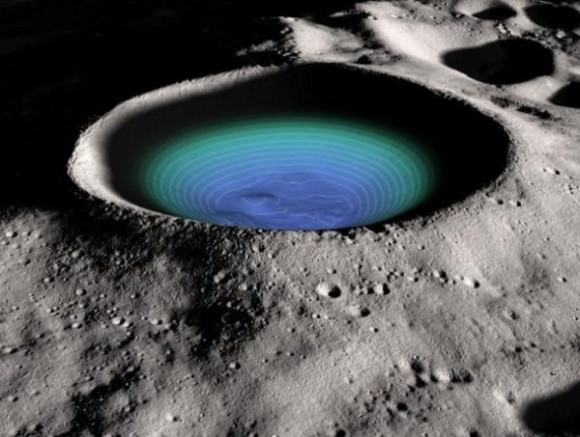
In addition to indicating the Solar System may be more watery than previously suspected, the presence of abundant ice on Mercury and the Moon has bolstered proposals for building outposts on these bodies. These outposts could be capable of turning local deposits water ice into hydrazine fuel, which would drastically reduce the costs of mounting long-range missions throughout the Solar System.
On the less-speculative side of things, this study also offers new insights into how the Solar System formed and evolved. If water is far more plentiful today than we knew, it would indicate that more was present during the early epochs of planetary formation, presumably when it was being distributed throughout the Solar System by asteroids and comets.
Further Reading: Brown University, Geophysical Research Letters
Good News for Future Moon Bases. There’s Water Inside the Moon
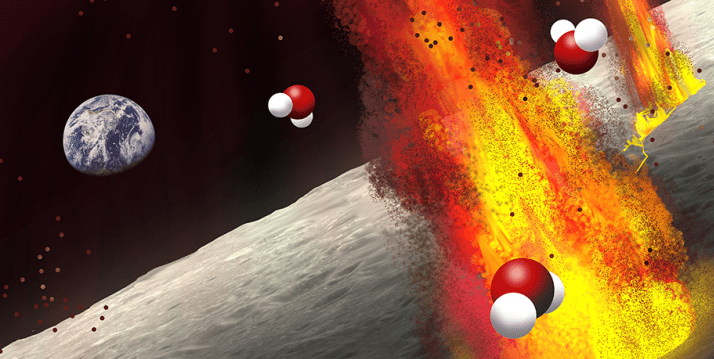
Since the Apollo program wrapped up in the early 1970s, people all around the world have dreamed of the day when we might return to the Moon, and stay there. And in recent years, however, that actual proposals for a lunar settlement have begun to take shape. As a result, a great deal of attention and research has been focused on whether or not the Moon has indigenous sources of water.
Thanks to missions like Chandrayaan-1 and the Lunar Reconnaissance Orbiter (LRO), scientists know that there are vast amounts of surface ice on the Moon. However, according to a new study, researchers from Brown University have found evidence of widespread water within volcanic deposits on the lunar surface. These findings could indicate that there are also vast sources of water within the Moon’s interior.
For their study – titled “Remote Detection of Widespread Indigenous Water in Lunar Pyroclastic Deposits” – Brown researchers Ralph E. Milliken and Shuai Li combined satellite data with new thermal profiles to search for signs of water away from the polar regions. In so doing, they addressed a long-standing theory about the likelihood of water in the Moon’s interior, as well as the predominant theory of how the Moon formed.
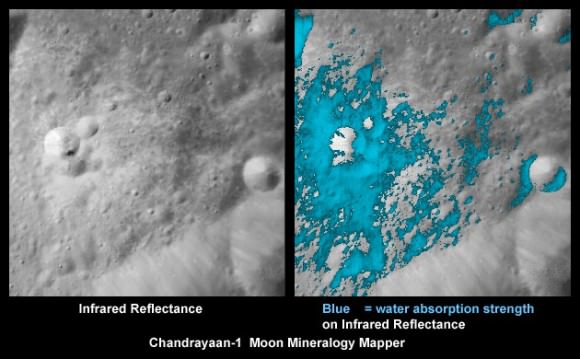
As noted, scientists have known for years that there are large amounts of frozen water in the Moon’s polar regions. At the same time, however, scientists have held that the Moon’s interior must have depleted of water and other volatile compounds billions of years ago. This was based on the widely-accepted hypothesis that the Moon formed after a Mars-sized object (named Theia) collided with Earth and threw up a considerable amount of debris.
Essentially, scientists believed that it was unlikely that any hydrogen – necessary to form water – could have survived the heat of this impact. However, as of a decade ago, new scientific findings began to emerge that cast doubt on this. The first was a 2008 study, where a team of researches (led by Alberto Saal of Brown University) detected trace amounts of water in samples of volcanic glass that were bought back by the Apollo 15 and Apollo 17 missions.
This was followed by a 2011 study (also from Brown University) that indicated how crystalline structures within those beads contained as much water as some basalt mineral deposits here on Earth. These findings were particularly significant, in that they suggested that parts of the Moon’s mantle could contain as much water as Earth’s. The question though was whether these findings represented the norm, or an anomaly.
As Milliken, an associate professor in Brown’s Department of Earth, Environmental, and Planetary Sciences (DEEPS) and the co-author on the paper, summarized in a recent Brown press release:
“The key question is whether those Apollo samples represent the bulk conditions of the lunar interior or instead represent unusual or perhaps anomalous water-rich regions within an otherwise ‘dry’ mantle. By looking at the orbital data, we can examine the large pyroclastic deposits on the Moon that were never sampled by the Apollo or Luna missions. The fact that nearly all of them exhibit signatures of water suggests that the Apollo samples are not anomalous, so it may be that the bulk interior of the Moon is wet.”
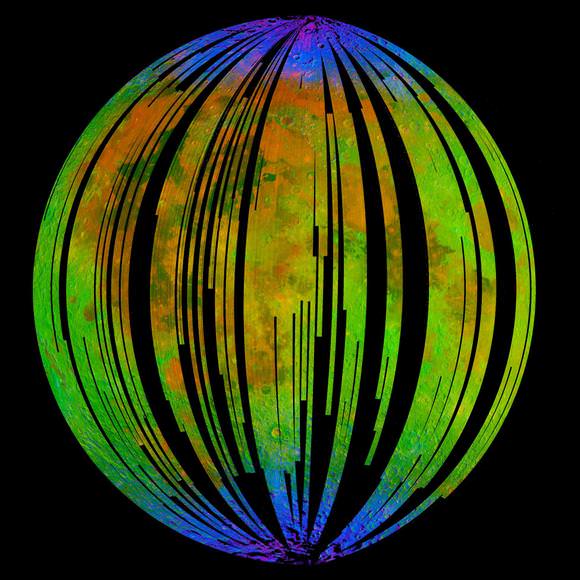
To resolve this, Milliken and Li consulted orbital data to examine lunar volcanic deposits for signs of water. Basically, orbiters use spectrometers to bounce light off the surfaces of planets and astronomical bodies to see which wavelengths of light are absorbed and which are reflected. This data is therefore able to determine what compounds and minerals are present based on the absorption lines detected.
Using this technique to look for signs of water in lunar volcanic deposits (aka. pyroclastic deposits), however, was a rather difficult task. During the day, the lunar surface heats up, especially in the latitudes where volcanic deposits are located. As Milliken explained, spectronomers will therefore pick up thermal energy in addition to chemical signatures which this can throw off the readings:
“That thermally emitted radiation happens at the same wavelengths that we need to use to look for water. So in order to say with any confidence that water is present, we first need to account for and remove the thermally emitted component.”
To correct for this, Milliken and Li constructed a detailed temperature profile of the areas of the Moon they were examining. They then examined surface data collected by the Moon Mineralogy Mapper, the spectrographic imager that was part of India’s Chandrayaan-1 mission. They then compared this thermally-corrected surface data to the measurements conducted on the samples returned from the Apollo missions.
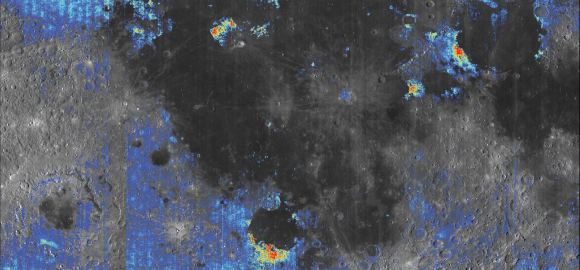
What they found was that areas of the Moon’s surface that had been previously mapped showed evidence of water in nearly all the large pyroclastic deposits. This included the deposits that were near the Apollo 15 and 17 landing sites where the lunar samples were obtained. From this, they determined that these samples were not anomalous in nature, and that water is distributed across the lunar surface.
What’s more, these findings could indicate that the Moon’s mantle is water-rich as well. Beyond being good news for future lunar missions, and the construction of a lunar settlement, these results could lead to a rethinking of how the Moon formed. This research was part of Shuai Li’s – a recent graduate of the University of Brown and the lead author on the study – Ph.D thesis. As he said of the study’s findings:
“The growing evidence for water inside the Moon suggest that water did somehow survive, or that it was brought in shortly after the impact by asteroids or comets before the Moon had completely solidified. The exact origin of water in the lunar interior is still a big question.
What’s more, Li indicated that lunar water that is located in volcanic deposits could be a boon for future lunar missions. “Other studies have suggested the presence of water ice in shadowed regions at the lunar poles, but the pyroclastic deposits are at locations that may be easier to access,” he said. “Anything that helps save future lunar explorers from having to bring lots of water from home is a big step forward, and our results suggest a new alternative.”
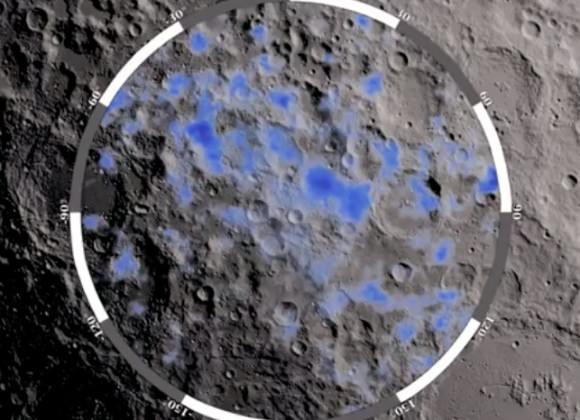
Between NASA, the ESA, Roscosmos, the ISRO and the China National Space Administration (CNSA), there are no shortage of plans to explore the Moon in the future, not to mention establishing a permanent base there. Knowing there’s abundant surface water (and maybe more in the interior as well) is therefore very good news. This water could be used to create hydrazine fuel, which would significantly reduce the costs of individual missions to the Moon.
It also makes the idea of a stopover base on the Moon, where ships traveling deeper into space could refuel and resupply – a move which would shave billions off of deep-space missions. An abundant source of local water could also ensure a ready supply of drinking and irrigation water for future lunar outposts. This would also reduce costs by ensuring that not all supplies would need to be shipped from Earth.
On top of all that, the ability to conduct experiments into how plants grow in reduced gravity would yield valuable information that could be used for long-term missions to Mars and other Solar bodies. It could therefore be said, without a trace of exaggeration, that water on the Moon is the key to future space missions.
The research was funded by the NASA Lunar Advanced Science and Exploration Research (LASER) program, which seeks to enhance lunar basic science and lunar exploration science.
Further Reading: Brown University
Weekly SkyWatcher’s Forecast: November 19-25, 2012
Greetings, fellow SkyWatchers! It’s going to be a great week to study the Moon – and bright Jupiter is just begging for some quality eyepiece time. Need more? Then why don’t we study some very interesting variable stars, too? It’s all out there… Just waiting on you!
Monday, November 19 – Now we’re ready for some serious lunar study. Our first order of business will be to identify crater Curtius. Directly in the center of the Moon is a dark-floored area known as the Sinus Medii. South of it will be two conspicuously large craters – Hipparchus to the north and ancient Albategnius to the south. Trace along the terminator toward the south until you have almost reached its point (cusp) and you will see a black oval. This normal looking crater with the brilliant west wall is equally ancient crater Curtius. Because of its high southern latitude, we shall never see the entire interior of this crater – and neither has the Sun! It is believed the inner walls are quite steep, and so crater Curtius’ full interior has never been illuminated since its formation billions of years ago. Because it has remained dark, we can speculate there may be “lunar ice” (water ice possibly mixed with regolith) pocketed inside its many cracks and rilles which date back to the Moon’s formation!
Because our Moon has no atmosphere, the entire surface is exposed to the vacuum of space. When sunlit, the surface reaches up to 385 K, so any exposed lunar ice would vaporize and be lost because the Moon’s gravity could not hold it. The only way for ice to exist would be in a permanently shadowed area. Near Curtius is the Moon’s south pole, and imaging from the Clementine spacecraft showed around 15,000 square kilometers of area where such conditions could exist. So where did this ice come from? The lunar surface never ceases to be pelted by meteorites – most of which contain water-related ice. As we know, many craters were formed by just such impacts. Once hidden from the sunlight, this ice could continue to exist for millions of years.
Now turn your eyes or binoculars just west of bright Aldebaran and have a look at the Hyades Star Cluster. While Aldebaran appears to be part of this large, V-shaped group, it is not an actual member. The Hyades cluster is one of the nearest galactic clusters, and it is roughly 130 light-years away in the center. This moving group of stars is drifting slowly away towards Orion, and in another 50 million years it will require a telescope to view!
Tuesday, November 20 – Today celebrates another significant astronomer’s birth – Edwin Hubble. Born 1889, Hubble became the first American astronomer to identify Cepheid variables in M31 – which in turn established the extragalactic nature of the spiral nebulae. Continuing with the work of Carl Wirtz, and using Vesto Slipher’s redshifts, Hubble then could calculate the velocity-distance relation for galaxies. This has become known as “Hubble’s Law” and demonstrates the expansion of our Universe.
Tonight we’re going to ignore the Moon and head just a little more than a fistwidth west of the westernmost bright star in Cassiopeia to have a look at Delta Cephei (RA 22 29 10.27 Dec +58 24 54.7). This is the most famous of all variable stars and the granddaddy of all Cepheids. Discovered in 1784 by John Goodricke, its changes in magnitude are not due to a revolving companion – but rather the pulsations of the star itself.
Ranging over almost a full magnitude in 5 days, 8 hours and 48 minutes precisely, Delta’s changes can easily be followed by comparing it to nearby Zeta and Epsilon. When it is its dimmest, it will brighten rapidly in a period of about 36 hours – yet take 4 days to slowly dim again. Take time out of your busy night to watch Delta change and change again. It’s only 1000 light-years away, and doesn’t even require a telescope! (But even binoculars will show its optical companion.)
Wednesday, November 21 – Before we go star hopping this evening, let’s go south on the lunar globe in hopes of catching a very unusual event. On the southern edge of Mare Nubium is the old walled plain Pitatus. Power up. On the western edge you will see smaller and equally old Hesiodus. Almost central along their shared wall there is a break to watch for when the terminator is close. For a brief moment, sunrise on the Moon will pass through this break creating a beam of light across the crater floor in a beautiful phenomenon known as the “Hesiodus Sunrise Ray.” For a very brief moment, a shaft of sunlight will shine through this break and create an experience you will never forget. If the terminator has moved beyond it at your observing time, then look to the south for small Hesiodus A. This is an example of an extremely rare double concentric crater. This formation is caused by one impact followed by another, slightly smaller impact, at exactly the same location.
Now, let’s continue our stellar studies with the central-most star in the lazy “W” of Cassiopeia – Gamma…
At the beginning of the 20th century, the light from Gamma appeared to be steady, but in the mid-1930s it took an unexpected rise in brightness. In less than 2 years it jumped by a magnitude! Then, just as unexpectedly, it dropped back down again in roughly the same amount of time. A performance it repeated some 40 years later!
Gamma Cassiopeiae isn’t quite a giant and is still fairly young on the evolutionary scale. Spectral studies show violent changes and variations in the star’s structure. After its first recorded episode, it ejected a shell of gas which expanded Gamma’s size by over 200% – yet it doesn’t appear to be a candidate for a nova event. The best estimate now is that Gamma is around 100 light-years away and approaching us at a very slow rate. If conditions are good, you might be able to telescopically pick up its disparate 11th magnitude visual companion, discovered by Burnham in 1888. It shares the same proper motion – but doesn’t orbit this unusual variable star. For those who like a challenge, visit Gamma again on a dark night! Its shell left two bright (and difficult!) nebulae, IC 59 and IC 63, to which we will return at the end of the month.
Thursday, November 22 – Tonight when you’re studying the Moon, return to our landmark Copernicus and travel south along the western shore of Mare Cognitum, the “Sea That Has Become Known” and look along the terminator for the Montes Riphaeus – “The Mountains In The Middle of Nowhere.” But are they really mountains? Let’s take a closer look. At the widest, this unusual range spans about 38 kilometers and runs for a distance of around 177 kilometers. Less impressive than most lunar mountain ranges, some peaks reach up to 1250 meters high, making these summits about the same height as our volcano Mt. Kilauea. While we are considering volcanic activity, consider that these peaks are all that is left of Mare Cognitum’s walls after lava filled it in. At one time this may have been amongst the tallest of lunar features!
Once you’ve studied the Montes Riphaeus, you’ll begin noticing another lunar crater that looks a whole lot like a smaller version of Copernicus – the highly under-rated crater Bullialdus. Located close to the center of Mare Nubium, even binoculars can make out Bullialdus when near the terminator. If you’re scoping – power up – this one is fun! Very similar to Copernicus, Bullialdus’ has thick, terraced walls and a central peak. If you examine the area around it carefully, you can note it is a much newer crater than shallow Lubiniezsky to the north and almost non-existent Kies (a real challenge) to the south. On Bullialdus’ southern flank, it’s easy to make out its A and B craterlets, as well as the interesting little Koenig to the southwest.
Friday, November 23 – Tonight in 1885, the very first photograph of a meteor shower was taken. Also, the weather satellite TIROS II was launched on this day in 1960. Carried to orbit by a three-stage Delta rocket, the “Television Infrared Observation Satellite” was about the size of a barrel, testing experimental television techniques and infrared equipment. Operating for 376 days, Tiros II sent back thousands of pictures of Earth’s cloud cover and was successful in its experiments to control the orientation of the satellite spin and its infrared sensors. Oddly enough, a similar mission – Meteosat 1 – also became the first satellite put into orbit by the European Space Agency, in 1977 on this day. Where is all this leading? Why not try observing satellites on your own! Thanks to wonderful on-line tools from NASA you can be alerted by e-mail whenever a bright satellite makes a pass for your specific area. It’s fun!
When you are ready to sail again, we’ll head to the Moon and cross the the western edge of the second largest lunar sea – Mare Imbrium – as we head northeast for the “lighthouse” points set on either side of the landmark “Bay of Rainbows”. They guard the opening to Sinus Iridum and they have names. The easternmost is Promentorium LaPlace, named for Pierre LaPlace. Little more than 56 kilometers in diameter, it rises above the gray sands some 3019 meters; almost identical in height to Buttermilk Mountain near Aspen. Promontorium Heraclides to the west covers roughly the same area, yet rises to little more than half of LaPlace’s height.
Saturday, November 24 – Tonight grab your telescope and head for the Moon and take another look at a feature you might have missed earlier in the year. ! Look west of very bright punctuation of crater Aristarchus for less prominent crater Herodotus. Just to the north you will see a fine white thread known as Schroter’s Valley. This inconspicuous feature winds its way across the Aristarchus plain for about 160 kilometers and measures about 3 to 8 kilometers wide, and about 1 kilometer deep. Schroter’s Valley is an example of a collapsed lava tube. It may have broken open when lava crossed the surface – or it may have settled downwards when a major meteor strike caused a shock wave. What we are looking at is a long, narrow cave on the surface which is very apparent when the lighting is correct.
Ready to aim for a bullseye? Then head for the bright, reddish star Aldebaran. Set your eyes, scopes or binoculars there and let’s look into the “eye” of the Bull.
Known to the Arabs as Al Dabaran, or “the Follower,” Alpha Tauri took its name for the fact that it appears to follow the Pleiades across the sky. In Latin it was Stella Dominatrix, yet the old English knew it as Oculus Tauri, or very literally the “eye of Taurus.” No matter which source of ancient astronomy lore we explore, there are references to Aldeberan.
As the 13th brightest star in the sky, it almost appears from Earth to be a member of the V-shaped Hyades star cluster, but its association is merely coincidental, since it is about twice as close to us as the cluster. In reality, Aldeberan is on the small end as far as K5 stars go, and like many other orange giants could possibly be a variable. Aldeberan is also known to have five close companions, but they are faint and very difficult to observe with backyard equipment. At a distance of approximately 68 light-years, Alpha is slightly less than 45 times larger than our own Sun and approximately 425 times brighter. Because of its position along the ecliptic, Aldeberan is one of the very few stars of first magnitude that can be occulted by the Moon.
Sunday, November 25 – As the Moon nears Full, it becomes more and more difficult to study, but there are still some features that we can take a look at. Before we go to our binoculars or telescopes, just stop and take a look. Do you see the “Cow Jumping over the Moon”? It is strictly a visual phenomenon—a combination of dark maria which looks like the back, forelegs and hindlegs of the shadow of that mythical animal.
While Cassiopeia is in prime position for most northern observers, let’s return tonight for some additional studies. Starting with Delta, let’s hop to the northeast corner of our “flattened W” and identify 520 light-year distant Epsilon. For larger telescopes only, it will be a challenge to find this 12″ diameter, magnitude 13.5 planetary nebula I.1747 in the same field as magnitude 3.3 Epsilon!
Using both Delta and Epsilon as our “guide stars” let’s draw an imaginary line between the pair extending from southwest to northeast and continue the same distance until you stop at visible Iota. Now go to the eyepiece…
As a quadruple system, Iota will require a telescope and a night of steady seeing to split its three visible components. Approximately 160 light-years away, this challenging system will show little or no color to smaller telescopes, but to large aperture, the primary may appear slightly yellow and the companion stars a faint blue. At high magnification, the 8.2 magnitude “C” star will easily break away from the 4.5 primary, 7.2″ to the east-southeast. But look closely at that primary: hugging in very close (2.3″) to the west-southwest and looking like a bump on its side is the B star!
Dropping back to the lowest of powers, place Iota to the southwest edge of the eyepiece. It’s time to study two incredibly interesting stars that should appear in the same field of view to the northeast. When both of these stars are at their maximum, they are easily the brightest of stars in the field. Their names are SU (southernmost) and RZ (northernmost) Cassiopeiae and both are unique! SU is a pulsing Cepheid variable located about 1000 light-years away and will show a distinctive red coloration. RZ is a rapidly eclipsing binary that can change from magnitude 6.4 to magnitude 7.8 in less than two hours. Wow!
Until next week? Clear skies!

